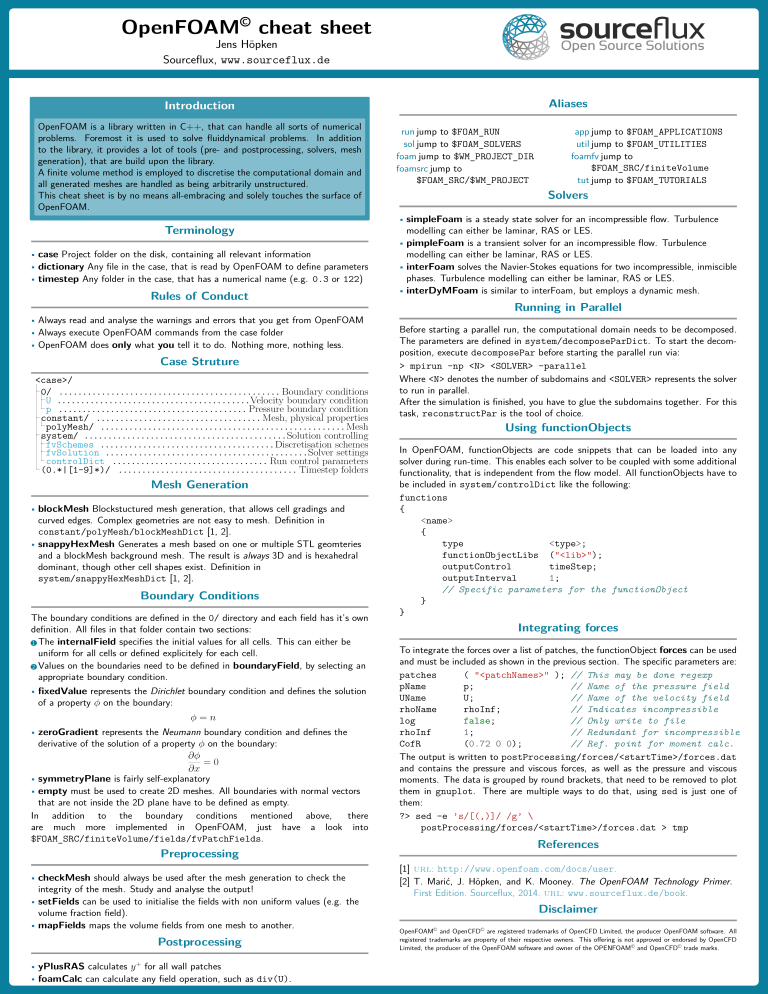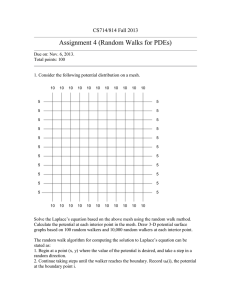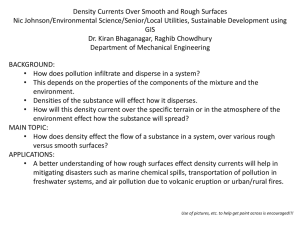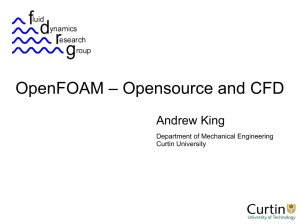
s
our
c
eflux
©
OpenFOAM cheat sheet
Jens Höpken
Sourceflux, www.sourceflux.de
Aliases
Introduction
OpenFOAM is a library written in C++, that can handle all sorts of numerical
problems. Foremost it is used to solve fluiddynamical problems. In addition
to the library, it provides a lot of tools (pre- and postprocessing, solvers, mesh
generation), that are build upon the library.
A finite volume method is employed to discretise the computational domain and
all generated meshes are handled as being arbitrarily unstructured.
This cheat sheet is by no means all-embracing and solely touches the surface of
OpenFOAM.
Terminology
• case Project folder on the disk, containing all relevant information
• dictionary Any file in the case, that is read by OpenFOAM to define parameters
• timestep Any folder in the case, that has a numerical name (e.g. 0.3 or 122)
Rules of Conduct
• Always read and analyse the warnings and errors that you get from OpenFOAM
• Always execute OpenFOAM commands from the case folder
• OpenFOAM does only what you tell it to do. Nothing more, nothing less.
Case Struture
<case>/
0/ ............................................... Boundary conditions
U .........................................Velocity boundary condition
p ........................................ Pressure boundary condition
constant/ ................................... Mesh, physical properties
polyMesh/ ....................................................Mesh
system/ ...........................................Solution controlling
fvSchemes .....................................Discretisation schemes
fvSolution ...........................................Solver settings
controlDict ................................. Run control parameters
(0.*|[1-9]*)/ ...................................... Timestep folders
Mesh Generation
• blockMesh Blockstuctured mesh generation, that allows cell gradings and
curved edges. Complex geometries are not easy to mesh. Definition in
constant/polyMesh/blockMeshDict [1, 2].
• snappyHexMesh Generates a mesh based on one or multiple STL geomteries
and a blockMesh background mesh. The result is always 3D and is hexahedral
dominant, though other cell shapes exist. Definition in
system/snappyHexMeshDict [1, 2].
Boundary Conditions
The boundary conditions are defined in the 0/ directory and each field has it’s own
definition. All files in that folder contain two sections:
1 The internalField specifies the initial values for all cells. This can either be
uniform for all cells or defined explicitely for each cell.
2 Values on the boundaries need to be defined in boundaryField, by selecting an
appropriate boundary condition.
• fixedValue represents the Dirichlet boundary condition and defines the solution
of a property φ on the boundary:
φ=n
• zeroGradient represents the Neumann boundary condition and defines the
derivative of the solution of a property φ on the boundary:
∂φ
=0
∂x
• symmetryPlane is fairly self-explanatory
• empty must be used to create 2D meshes. All boundaries with normal vectors
that are not inside the 2D plane have to be defined as empty.
In addition to the boundary conditions mentioned above,
there
are much more implemented in OpenFOAM, just have a look into
$FOAM_SRC/finiteVolume/fields/fvPatchFields.
Preprocessing
• checkMesh should always be used after the mesh generation to check the
integrity of the mesh. Study and analyse the output!
• setFields can be used to initialise the fields with non uniform values (e.g. the
volume fraction field).
• mapFields maps the volume fields from one mesh to another.
Postprocessing
• yPlusRAS calculates y + for all wall patches
• foamCalc can calculate any field operation, such as div(U).
run jump to $FOAM_RUN
sol jump to $FOAM_SOLVERS
foam jump to $WM_PROJECT_DIR
foamsrc jump to
$FOAM_SRC/$WM_PROJECT
app jump to $FOAM_APPLICATIONS
util jump to $FOAM_UTILITIES
foamfv jump to
$FOAM_SRC/finiteVolume
tut jump to $FOAM_TUTORIALS
Solvers
• simpleFoam is a steady state solver for an incompressible flow. Turbulence
modelling can either be laminar, RAS or LES.
• pimpleFoam is a transient solver for an incompressible flow. Turbulence
modelling can either be laminar, RAS or LES.
• interFoam solves the Navier-Stokes equations for two incompressible, inmiscible
phases. Turbulence modelling can either be laminar, RAS or LES.
• interDyMFoam is similar to interFoam, but employs a dynamic mesh.
Running in Parallel
Before starting a parallel run, the computational domain needs to be decomposed.
The parameters are defined in system/decomposeParDict. To start the decomposition, execute decomposePar before starting the parallel run via:
> mpirun -np <N> <SOLVER> -parallel
Where <N> denotes the number of subdomains and <SOLVER> represents the solver
to run in parallel.
After the simulation is finished, you have to glue the subdomains together. For this
task, reconstructPar is the tool of choice.
Using functionObjects
In OpenFOAM, functionObjects are code snippets that can be loaded into any
solver during run-time. This enables each solver to be coupled with some additional
functionality, that is independent from the flow model. All functionObjects have to
be included in system/controlDict like the following:
functions
{
<name>
{
type
<type>;
functionObjectLibs ("<lib>");
outputControl
timeStep;
outputInterval
1;
// Specific parameters for the functionObject
}
}
Integrating forces
To integrate the forces over a list of patches, the functionObject forces can be used
and must be included as shown in the previous section. The specific parameters are:
patches
( "<patchNames>" ); // This may be done regexp
pName
p;
// Name of the pressure field
UName
U;
// Name of the velocity field
rhoName
rhoInf;
// Indicates incompressible
log
false;
// Only write to file
rhoInf
1;
// Redundant for incompressible
CofR
(0.72 0 0);
// Ref. point for moment calc.
The output is written to postProcessing/forces/<startTime>/forces.dat
and contains the pressure and viscous forces, as well as the pressure and viscous
moments. The data is grouped by round brackets, that need to be removed to plot
them in gnuplot. There are multiple ways to do that, using sed is just one of
them:
?> sed -e ’s/[(,)]/ /g’ \
postProcessing/forces/<startTime>/forces.dat > tmp
References
[1] url: http://www.openfoam.com/docs/user.
[2] T. Marić, J. Höpken, and K. Mooney. The OpenFOAM Technology Primer.
First Edition. Sourceflux, 2014. url: www.sourceflux.de/book.
Disclaimer
OpenFOAM© and OpenCFD© are registered trademarks of OpenCFD Limited, the producer OpenFOAM software. All
registered trademarks are property of their respective owners. This offering is not approved or endorsed by OpenCFD
Limited, the producer of the OpenFOAM software and owner of the OPENFOAM© and OpenCFD© trade marks.




